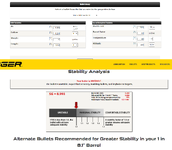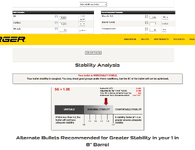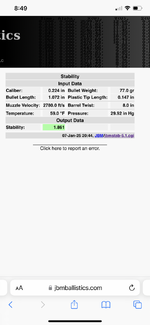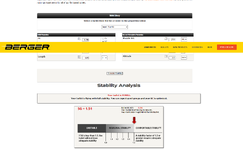Oops. Missed that.He said in the first post he verified the twist with a cleaning rod.
Jeremy
Follow along with the video below to see how to install our site as a web app on your home screen.
Note: This feature may not be available in some browsers.
Oops. Missed that.He said in the first post he verified the twist with a cleaning rod.

Interesting, maybe he didn't account for the change in BC. Good catch!At your temp and altitude I get you velocity to be 1203 fps at 840 yards according to jbm. Sierra lists the bc to be .380 @ 1750 fps and lower. When I plug in those numbers to Berger's Barrel Twist Calculator here the twist rate I get. View attachment 818670
Thanks. Just a suggestion on what might be happening. Hard tellin not knowin.Interesting, maybe he didn't account for the change in BC. Good catch!
At your temp and altitude I get you velocity to be 1203 fps at 840 yards according to jbm. Sierra lists the bc to be .380 @ 1750 fps and lower. When I plug in those numbers to Berger's Barrel Twist Calculator here the twist rate I get. View attachment 818670
However you'd like to explain it. In any case the 77gr TMK has marginal stability according to Berger's calculator.It doesn't work that way. 1203 FPS is not the muzzle velocity. Muzzle velocity is important because that's how you calculate bullet RPM. Bullet RPM decreases much slower than velocity, thus they'll be spinning much faster at 800+ yards than what the scenario you ran indicates.
More RPM = More stability.

I think because you’re using the full length including the polymer tip in the Berger calc? Jbm says it’s plenty at standard atmosphere when tip details are entered.According to the above screen shot Berger says to decrease the BC by 4%. If I plug in a 1-8.1" twist it decreases the BC by 5%. Which could put the bullet transonic at 840 yards. 1-8.2" twist drops the BC to 6%.

Ok well in any case the bullets are keyholing lol.I think because you’re using the full length including the polymer tip in the Berger calc? Jbm says it’s plenty at standard atmosphere when tip details are entered.
View attachment 818873
My .308 is afflicted by this, 168 SMK shoots great out to 800 anything past that it like throwing the dice, probably a 36" "pattern" at 1000 yards. At 800 it a sub MOA.I'd bet money it's transonic instability. The symptoms you described and the ballistics table posted above certainly point to that being the culprit.
This is true for supersonic flight down to transonic range - speed and dynamic pressure decrease, but RPM decreases more slowly. As you enter transonic range (~Mach 0.8-1.2), the fluid dynamics are transitioning rapidly and inconsistently from supersonic to subsonic flow. The aerodynamic center of pressure on the bullet changes drastically and dynamically (even back and forth) during this regime. Bullets absolutely need to be designed for these regimes to work well, and there are some famous ones (Sierra 168gr Matchkings for instance) that have a well known transonic instability (the 175gr Matchking was partially redesigned to address this, Litz writes about it).
A faster twist can help increase stability through this regime.
My PSS 308 Win is okay out to 1200 yards depending on the day @ 2200 ft elevation. 168gr SMK or CC acts about the same.My .308 is afflicted by this, 168 SMK shoots great out to 800 anything past that it like throwing the dice, probably a 36" "pattern" at 1000 yards. At 800 it a sub MOA.
Twist rate? Also what is your definition of "okay"?My PSS 308 Win is okay out to 1200 yards depending on the day @ 2200 ft elevation. 168gr SMK or CC acts about the same.
I know mine is slower than 1-10". I can't remember offhand but I think it's something like 1-11.25". It still shoot around .5 moa with the right loads.Twist rate? Also what is your definition of "okay"?
Edit: I ask because faster than usual twist (say 1:10 rather than 1:12) and high DA would increase stability such that you might not see this until beyond 1200. Also higher MV. And at 1200 there are enough other large sources of error you might not necessarily notice the effect of the instability.
The reason why I'd want a faster twist is to try some 208gr or heavier in my 308 win.Twist rate? Also what is your definition of "okay"?
Edit: I ask because faster than usual twist (say 1:10 rather than 1:12) and high DA would increase stability such that you might not see this until beyond 1200. Also higher MV. And at 1200 there are enough other large sources of error you might not necessarily notice the effect of the instability.
According to this article plastic tips elongate the bullets without adding much mass. So they require faster twist. the formula in jbm's site does the opposite. jbm's calculator could be more accurate, but the keyholing suggests otherwise. https://www.xxlreloading.com/post/how-do-you-determine-the-suitable-barrel-twist-rate
Okay well I'll stand by what I posted because it does illustrate the OP's TMK being unstable. Here's a screen shot of the Berger 75 VLD with the same inputs as the OP's TMK. It seems to mirror the article I posted earlier.Context in that is important. If we compare a TMK with tip in place to one without the tip, the one without a tip will require less RPM for get get exact same stability because its shorter but it also has a shittier form factor. So in that case, yes the tip may make it require more RPM. However, if you compared the plastic tip bullet to say a BTHP with same weight and BC, the tipped bullet may be a hair longer but probably doesn't need more twist.
Example: Berger 75 VLD @ 1.051" is going to need more RPMs to achieve identical stability to the 77 TMK @ 1.065" including the 0.147" tip with the same velocity and twist rate due to the shape of the bullet - less bearing surface, longer nose, etc.

Okay well I'll stand by what I posted because it does illustrate the OP's TMK being unstable. Here's a screen shot of the Berger 75 VLD with the same inputs as the OP's TMK. It seems to mirror the article I posted earlier.
View attachment 820240
